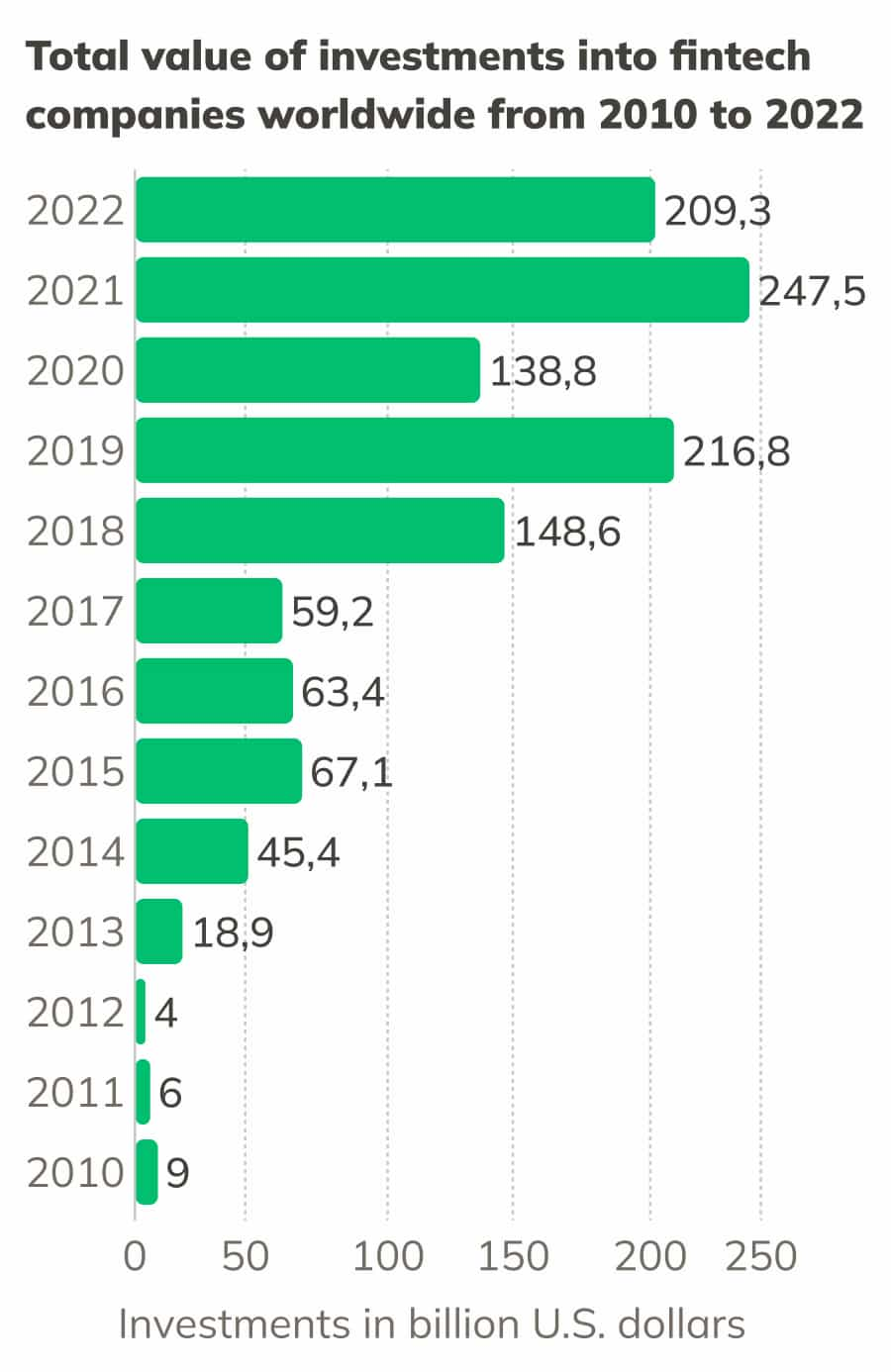Must-Have Features of a Fintech App
Topic: Guides

January 19, 2024
What is a fintech app? How to build a fintech app? These questions are popular among modern entrepreneurs who keep up with the times and follow the latest technologies.
Fintech is one of the most developed and promising industries in the world today. It includes a huge list of services: payment of bills, money transfers, insurance, investments, management of crypto exchanges, various types of loans, and, of course, banks.
The fintech industry was growing at an extraordinary pace between 2012 and 2021, including the number of fintech startups and investments. Although growth has slowed down somewhat in the following years, fintech application development remains popular and in demand.

At the beginning of 2024, the fintech industry is still highly competitive with many players offering similar services. Therefore, entrepreneurs entering this race need to differentiate their app by offering unique value propositions, superior user experience or innovative features.
Essential Fintech App Features
The specific features required may vary depending on the target audience and the type of financial services being provided. However, some must-have features are commonly found in successful fintech apps. Let’s take a closer look at some of them!
Security Features
In recent years, data breaches and cyber thefts have become increasingly prevalent. As more of our personal information and business data are stored and transmitted digitally, the potential for unauthorized access and malicious activities has grown significantly.
Therefore, security is an essential attribute of any fintech application. Customers want to be confident that their sensitive data will be protected from potential threats. To solve this problem, you need to implement multifactor authentication along with secure login methods.
The use of advanced technology such as biometrics, fingerprint readers, facial recognition, secure codes and others can significantly improve the login process. By prioritizing security measures, mobile apps can provide users with a safe and secure mobile experience, instilling confidence in the protection of their data.
Account Management
Fintech apps should provide users with the ability to manage their accounts. This includes features like viewing account balances, transaction history, and managing personal details. Users should be able to update personal information, link bank accounts or payment methods, and set preferences.
Some of the key features that providers should focus on include:
- Make payments,
- Transfer money between accounts,
- View account balances and transactions,
- View account statements,
- Set up recurring payments or transfers.
Digital Payments
Digital payment functionality is another important feature that ranks high on the priority list for most customers. In today's cashless era, mobile banking apps must provide seamless access to various digital payments including mobile wallets, UPI (Unified Payments Interface) and more.
With these features, customers can conveniently pay bills, initiate recurring payments, and manage their accounts. Setting up recurring payments with automatic debits to a user's account can be particularly beneficial as it helps users avoid missing payment dates.
Moreover, a fintech app equipped with digital payment alternatives allows users to conduct transactions and access their account information on the go, eliminating the need to physically visit a bank for cash transactions. This enhances convenience and gives users control over their finances wherever they are.
Money Transfers
When discussing digital payments, the ability to transfer money is undeniably one of the most crucial features. It empowers users to swiftly and effortlessly send money to their loved ones across the globe with just a simple click.
To broaden their reach and impact, fintech providers should prioritize the development of a money transfer feature within their apps. This strategic move will allow them to capitalize on the expanding global remittance market, catering to the increasing demand for seamless and efficient cross-border money transfers.
As an example, one of Cyfrania's fintech projects comes to mind. Not long ago, our team developed a new online peer-to-peer lending service for an international fintech company. Fast money transfers were an integral and important feature of this application, as it enables a real lending and borrowing process between individuals.
Integration With Other Financial Services
A notable feature of fintech applications is their ability to seamlessly integrate with other financial applications and services. This functionality improves the overall user experience and provides users with a comprehensive and interconnected financial ecosystem.
By integrating with other financial applications and services, fintech applications can offer some benefits. For example, users can conveniently link their bank accounts, investment platforms, or payment systems to a fintech app. This integration allows real-time access to financial data such as account balances, transaction history, and investment performance within a single application interface.
In addition, integration with external financial services allows users to utilize additional features and services that third-party providers may offer. These could be features such as loan applications, credit scoring, budgeting tools, or even personalized financial advice.
Going back to the peer-to-peer lending application mentioned above, one of the key requirements of the customer was integration with the banking system of the target country. The application should provide fast transaction processing and support multiple currencies. It also needed integration with the state tax service database to extract borrowers' income and credit history data.
Personalized Experiences
The expectations of fintech app users now revolve around personalized experiences. They desire the ability to use the app in a manner that aligns with their convenience and comfort. As a result, fintech applications need to be adaptable and customizable to cater to the distinct requirements of each user.
One effective approach to achieve this is through the implementation of user profiles, allowing individuals to input their personal information and preferences. By leveraging this data, the app can deliver an experience tailored to the specific user.
Furthermore, personalization features like setting spending goals, utilizing budgeting tools, and configuring personalized notifications empower users to take charge of their finances and effortlessly track their spending.
Personalization plays a pivotal role in the success of fintech applications. If users perceive that an app does not cater to their specific needs, their interest will quickly diminish, potentially leading to disengagement. Therefore, fintech service providers that prioritize delivering personalized experiences are more likely to attract and retain customers effectively.
Real-Time Notifications and Alerts
Real-time notifications and alerts keep users informed about their financial activities. These can include transaction alerts, account balance updates, payment reminders, and security alerts for suspicious activities.
If warnings become excessively intrusive or frequent, customers may find them bothersome. To address this, users should have the ability to customize their notification preferences, selecting the specific information they wish to receive, as well as the timing and frequency of such notifications. By offering this level of flexibility, customers can benefit from receiving important alerts without the risk of missing them.
Customer Support and Chatbot
It's not uncommon for even the most exceptional fintech apps to experience occasional glitches or issues that require attention. Therefore, it is crucial for apps to establish a robust customer support system to assist users whenever they encounter difficulties. This ensures that users have access to the necessary help and guidance whenever they require it.
Customer support channels for users can include features like in-app chat support, FAQs, and even AI-powered chatbots to address common queries and provide instant support.
As for the previously mentioned peer-to-peer lending service, the Cyfrania team has made an online chat with the app's account manager. In addition, the user can contact the management with questions via a feedback form or email.
Pitfalls of Feature Overload
When entrepreneurs come up with the idea of developing a fintech application, they need to carefully consider which features it should contain. The features can vary depending on the tasks to be performed and the characteristics of the target group. Often, entrepreneurs want to add as many features as possible to make their fintech application faster, more efficient and more modern. But more is not always better. If an app is overloaded with different functions, this can harm the user experience.
When an application becomes overloaded with features, it can lead to several issues:
- Complexity: An app with numerous features can make it difficult for users to find their way around and understand how to use the various functions. This complexity can frustrate users who are looking for a streamlined and intuitive experience.
- Cluttered interface: Adding too many features often results in a cluttered interface that makes it difficult for users to find and access the features they need. This can lead to frustration and lower user satisfaction.
- Performance issues: Every additional function in a fintech application requires resources such as computing power, memory, and network bandwidth. If an application is not properly optimized, it can become slower, less responsive, and prone to crashes.
- Increased maintenance and support: The more features an application has, the more difficult and time-consuming it is to maintain and support. Each new feature can lead to bugs, compatibility issues, and security vulnerabilities. This requires additional resources for ongoing maintenance and updates.
To avoid the problems above, entrepreneurs are advised to research the market to get an idea of who the potential users of the app are, and what their preferences and financial needs are. Based on this information, entrepreneurs will be able to determine the features, functionality, and usability of their future fintech app.
Conclusion
Creating a successful fintech app is a challenging process as it requires a combination of advanced technology, user-centric design and strict security measures.
The Cyfrania team has proven its effectiveness in assisting numerous companies in providing comprehensive financial services solutions. Based on our 20+ years of experience, we always recommend that our customers conduct user research, gather feedback, and conduct usability testing to identify the core features that provide the most value to users.